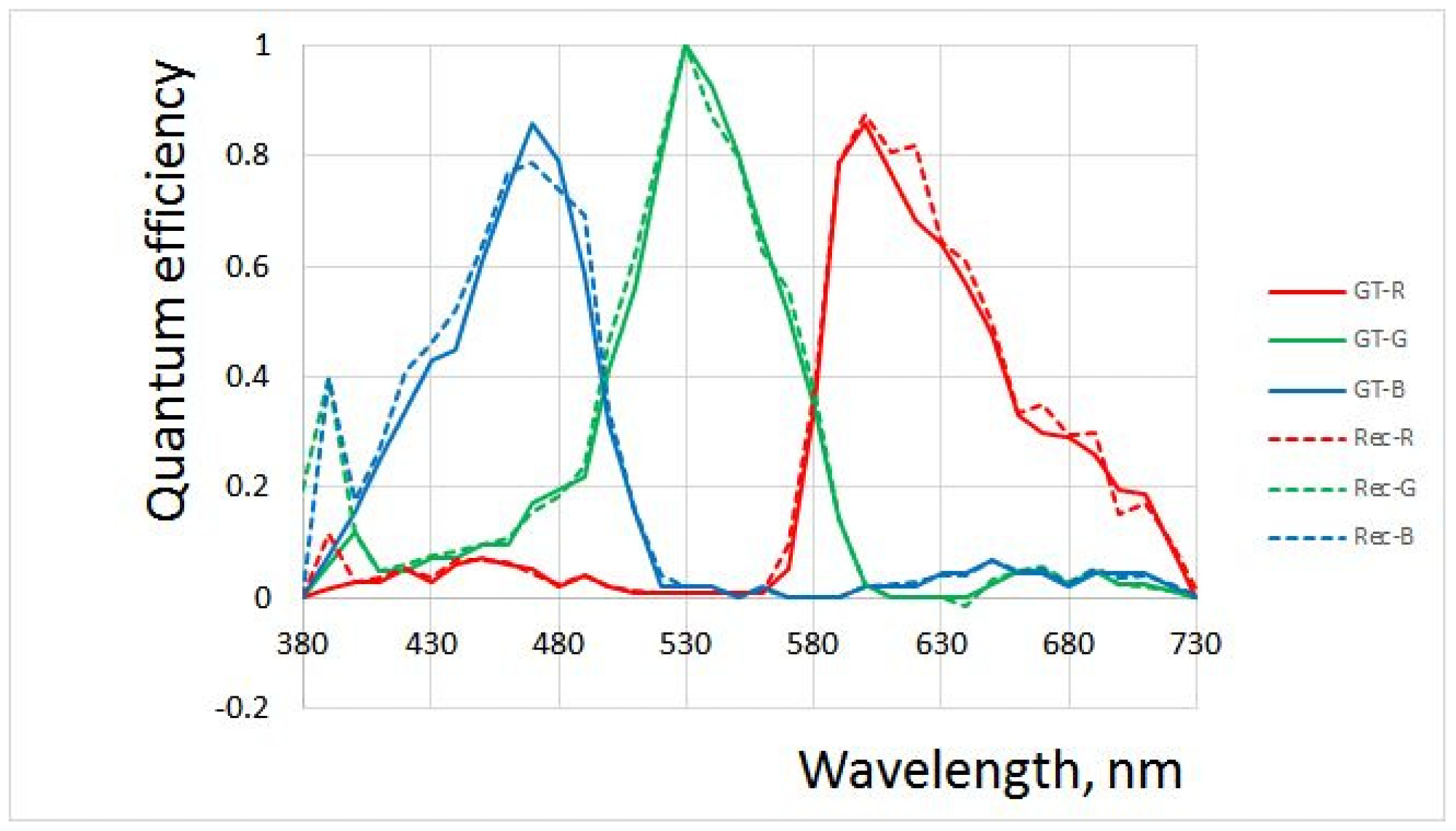A paper published in the Journal of Imaging has proposed a novel approach for accurate camera quantum efficiency (QE) determination from a single image.
 Difference between ground truth (GT) and recovered (Rec) quantum efficiency curves for 10 nm Omega Optical filters. Image Credit: https://www.mdpi.com/2313-433X/10/7/169
Difference between ground truth (GT) and recovered (Rec) quantum efficiency curves for 10 nm Omega Optical filters. Image Credit: https://www.mdpi.com/2313-433X/10/7/169
QEC Estimation Challenges
Determining the camera's spectral sensitivity or quantum efficiency (QE) is essential for addressing various image acquisition issues. These include color correction for comparing images taken with different cameras and under varying lighting conditions, as well as accurately reconstructing an object's true color when captured through absorbing mediums like water.
Directly estimating the QE curve (QEC) is both tedious and complex, requiring specialized equipment. Additionally, many camera manufacturers do not make spectral characteristics publicly available. While this has led to the development of indirect QEC estimation methods, these techniques often prove unreliable due to their high sensitivity to input data noise.
As a result, obtaining a reliable and efficient sensor QEC estimation remains a significant challenge for small companies and individual photographers who lack access to expensive equipment. This underscores the need for a method that allows for accurate and rapid QEC determination.
The Proposed Approach
In this study, the researcher introduced a novel technique and device for determining the QEC of photo or video cameras using only a single image. The primary aim was to address the instability issues often encountered in QEC determination and to present a method that ensures stable QEC reconstruction even in the presence of noise.
The proposed device features a set of ultra-narrow band-pass interference filters designed to achieve reliable and noise-tolerant QEC recovery. The filters have minimal spectral overlap, which contributes to accurate QEC estimation. The number of wavelengths at which QECs are recovered depends on the number of filters used.
For optimal accuracy, filters with a full width at half maximum (FWHM) of 3 nm were employed. These filters, with non-overlapping bands, were illuminated using a broadband light source diffused through a diffusion plate to ensure spatial homogenization. The transmitted light blob was then captured in a photograph.
The typical filter sizes used were 1 inch and 1/2 inch. Given the impracticality of using a single light source due to uneven illumination across forty filters arranged in an 8 by 5 array (approximately 16 by 10 cm), an array of identical light-emitting diodes (LEDs) was used. Each LED illuminated its corresponding interference filter.
To minimize ambient light interference, the image was captured in a dark room. The image depicted a cell array of interference filters covering the entire visible spectrum. The average intensity around the brightest pixel in each cell was calculated, with the radius for averaging consistent across all cells and determined by the camera's resolution. Reflectivity vectors were derived from each cell’s peak wavelength and converted into RGB triplets.
For implementation, Thorlabs, Andover Corporation, Omega Optical, and Spectrogon were identified as sources for comprehensive narrow band-pass interference filter sets. Simulations demonstrated that QECs recovered using 10 nm FWHM Omega Optical filters had a significant standard deviation of error, approximately 5 percent (σ = 0.051192), consistent with a condition number value of 1237.71.
In contrast, 3 nm FWHM filters from Andover Corporation, which have nearly non-overlapping spectra, resulted in a standard deviation of error of σ = 0.00204. This indicates minimal difference between recovered and true QECs. Notably, the simulations showed that even with noisy RGB triplet measurements, the recovered QECs had lower noise. For example, the standard deviation of error for QECs did not exceed 5 % when the RGB triplet error was 15 %.
The proposed method was validated with a single Thorlabs interference filter with a peak transmittance at 532 nm and an FWHM of 3 nm due to the high cost of acquiring a full set of filters.
Study Significance
The numerical results revealed that the amplification of input data noise was the primary cause of inaccuracies in reconstructing QECs from colored chip images. Noise reduction was effectively achieved by using a non-overlapping set of input data signals from ultra-narrow band filters.
The proposed approach allows for faster QEC estimation compared to existing methods, requiring only a single photograph. Specifically, this technique can estimate QECs in just a few seconds from a single image, whereas the traditional "Gold Standard" technique, which requires 20–30 minutes to measure 36 points on the QECs, is significantly slower.
In summary, this study demonstrated that accurate camera QEC determination can be achieved from a single image using ultra-narrow band interference filters, even in the presence of input data noise. The proposed device offers a valuable tool for camera and imaging sensor manufacturers, as well as individual photographers, enabling rapid colorimetric calibration.
Journal Reference
Rzhanov, Y. (2024). Accurate Determination of Camera Quantum Efficiency from a Single Image. Journal of Imaging, 10(7), 169. DOI:10.3390/jimaging10070169, https://www.mdpi.com/2313-433X/10/7/169
Disclaimer: The views expressed here are those of the author expressed in their private capacity and do not necessarily represent the views of AZoM.com Limited T/A AZoNetwork the owner and operator of this website. This disclaimer forms part of the Terms and conditions of use of this website.